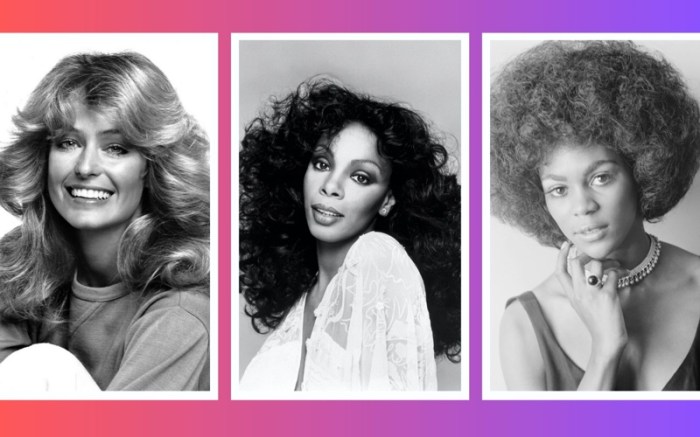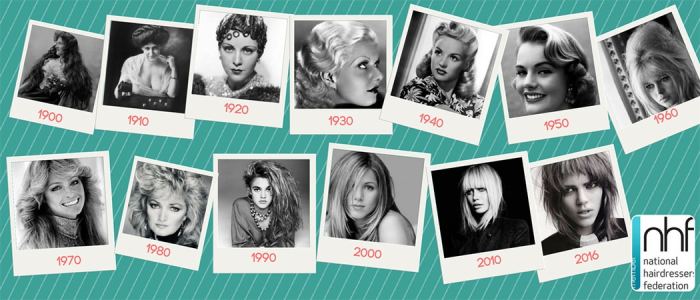Long Hair Retro Hairstyles A Stylish Journey
Long Hair Retro Hairstyles: A Journey Through Time
From the flapper waves of the roaring twenties to the Farrah Fawcett flip of the seventies, long hair retro hairstyles have consistently defined eras and influenced fashion. This exploration delves into the evolution of these iconic looks, examining their defining characteristics, cultural impact, and modern reinterpretations.
Defining “Long Hair Retro Hairstyles”
The term “long hair retro hairstyles” encompasses a wide range of styles popularized in the past, typically spanning from the 1920s to the late 1980s. These styles are characterized by their distinct shapes, textures, and accessories, reflecting the prevailing fashion and cultural trends of their respective decades.
The evolution of long hair styles throughout these decades reveals a fascinating interplay between societal shifts and aesthetic preferences. The 1920s saw long hair styled in loose waves and finger waves, often adorned with headbands and feathers, reflecting a sense of newfound freedom and modernity. The 1960s brought about the voluminous bouffants and sleek, straight styles, mirroring the era’s optimism and rebellious spirit.
The 1970s embraced natural textures and layers, with styles like the Farrah Fawcett flip symbolizing a move towards greater individuality and self-expression. Key characteristics defining a “retro” hairstyle include its historical context, distinctive silhouette, and use of techniques and products prevalent during its era.
Comparing long hair styles across these eras reveals a striking contrast. The structured, often tightly controlled styles of the 1920s and 1960s stand in stark contrast to the more free-flowing and natural looks of the 1970s. This shift reflects broader changes in social attitudes and fashion preferences.
| Era | Hairstyle Name | Description | Notable Features |
|---|---|---|---|
| 1920s | Finger Waves | Long hair styled in a series of S-shaped waves using fingers and setting lotion. | Defined waves, often worn with headbands or decorative clips. |
| 1960s | Bouffant | Voluminous hairstyle achieved by backcombing the hair at the crown and teasing it to create height. | High volume, often paired with a sleek, straight lower section. |
| 1970s | Farrah Fawcett Flip | Layered hairstyle with long, face-framing layers that flipped outward at the ends. | Layered texture, feathered ends, often styled with a round brush. |
| 1980s | Big Hair | Extremely voluminous hairstyle with lots of body and height, often achieved with teasing and hairspray. | Excessive volume, often styled with crimping irons or large rollers. |
Iconic Long Hair Retro Hairstyles
Several long hair retro hairstyles have achieved iconic status, shaping cultural perceptions of beauty and influencing generations of stylists. These styles not only reflected the trends of their time but also became powerful symbols of social and cultural movements.
Five iconic examples include the 1920s finger waves, the 1960s bouffant, the 1970s Farrah Fawcett flip, the 1980s big hair, and the 1970s shag. The styling techniques varied greatly; finger waves relied on precise manipulation and setting lotion, while the bouffant depended on backcombing and teasing. The Farrah Fawcett flip required layering and round brushing, big hair relied on volumizing products and teasing, and the shag utilized layering and texturizing techniques.
These styles were popularized by celebrities and cultural figures such as Clara Bow (finger waves), Brigitte Bardot (bouffant), Farrah Fawcett (Farrah Fawcett flip), and many pop stars of the 1980s (big hair).
Detailed Styling of a 1970s Shag: Begin with layered hair. Apply a volumizing mousse. Rough dry the hair using your fingers. Use a round brush to add volume and shape to the layers, focusing on the face-framing sections. Finish with a texturizing spray to enhance the tousled effect.
Variations and Modern Interpretations

Source: fashiongonerogue.com
Retro hairstyles have experienced a continuous cycle of reinvention, adapting to modern aesthetics and techniques. While retaining their essence, modern interpretations often incorporate updated styling methods and products.
Authentic retro styles emphasize the specific techniques and products of their era, resulting in a look that captures the spirit of the time. Modern adaptations, on the other hand, may draw inspiration from the original styles but utilize contemporary tools and techniques to achieve a more updated and wearable look. For example, while the original bouffant relied heavily on backcombing, modern interpretations might use volumizing products and techniques to create a similar effect with less damage to the hair.
Similarly, hairsprays have evolved from their stiff, crunchy predecessors to lightweight, flexible alternatives.
- Modern Bouffant Variations: Use of volumizing mousse and root lift spray instead of excessive backcombing; incorporation of modern styling tools like curling irons for added volume and texture; softer, less structured silhouette.
- Modern Farrah Fawcett Flip Variations: Use of modern layering techniques for a more natural look; incorporation of texturizing sprays and serums for a softer, less rigid flip; variations in length and layering for individual customization.
- Modern Shag Variations: Emphasis on choppy layers for a more contemporary feel; incorporation of balayage or ombre techniques for added dimension; styling with texturizing products for a tousled, less structured look.
Styling Long Hair for a Retro Look
Achieving a specific retro hairstyle requires careful attention to technique and product selection. The following steps illustrate how to style a 1970s-inspired long layered hairstyle.
Long hair retro hairstyles offer a cool, classic vibe, often incorporating elements like waves and volume. For those with thick, straight hair seeking a similar aesthetic, exploring options like a textured pompadour or a sleek side part can be a great starting point. If you’re looking for specific styling ideas to manage that thickness, check out this helpful guide on hairstyles for thick straight hair guys before settling on your final retro look.
Ultimately, the key is finding a retro style that complements your hair type and personal style.
- Wash and condition hair.
- Apply a volumizing mousse to damp hair.
- Rough dry hair using your fingers to create texture.
- Use a large round brush to curl sections of hair, focusing on the ends.
- Apply a texturizing spray for added volume and separation.
- Use your fingers to tousle the hair, creating a soft, undone look.
Hair texture and length play a crucial role in achieving different retro looks. Fine hair may require more volumizing products, while thick hair might need more layering to achieve the desired shape. Length influences the overall silhouette of the hairstyle, impacting the volume and movement.
| Product/Tool | Purpose |
|---|---|
| Volumizing mousse | Adds body and lift to the hair. |
| Round brush | Creates volume and curl. |
| Texturizing spray | Adds texture and separation. |
| Hairspray | Provides hold and sets the style. |
Maintaining a retro hairstyle throughout the day often requires the use of hairspray and careful placement of pins or clips to maintain the style’s shape.
The Influence of Culture and Fashion, Long hair retro hairstyles

Source: 77thehill.com
Societal trends and cultural influences significantly impacted the evolution of long hair retro hairstyles. These styles acted as both reflections and drivers of broader cultural shifts.
Fashion icons and media played a vital role in popularizing specific hairstyles. The media’s portrayal of celebrities sporting certain styles often led to widespread adoption. The relationship between long hair retro hairstyles and subcultures of the time is evident in styles that became associated with specific groups or movements. For example, certain hairstyles became linked to particular social or political movements, representing rebellion or conformity.
1970s Hairstyle Timeline:
- Early 1970s: The sleek, straight styles of the late 1960s begin to give way to more natural, textured looks. Influenced by the counterculture movement and a growing emphasis on individuality.
- Mid-1970s: The Farrah Fawcett flip emerges as an iconic style, symbolizing the era’s focus on natural beauty and self-expression. Influenced by the rise of television and the popularity of female role models.
- Late 1970s: The shag and other layered styles gain popularity, reflecting a move towards more textured and less structured looks. Influenced by the disco era and a broader shift in fashion towards more relaxed styles.
Common Queries
Can I achieve a retro hairstyle with any hair type?
While some styles are better suited to certain hair textures, with the right techniques and products, most retro looks can be adapted for various hair types. Experimentation and the use of styling aids are key.
How do I maintain a retro hairstyle throughout the day?
Strong hold hairspray, regular touch-ups, and potentially the use of hairpins or clips can help maintain your retro style. The specific techniques will depend on the chosen hairstyle.
Are there any modern products that can help achieve authentic retro looks?
Yes, many modern hair products, such as volumizing mousses, texturizing sprays, and strong-hold hairsprays, can help create the texture and hold necessary for authentic retro styles. However, some techniques may require practice.













